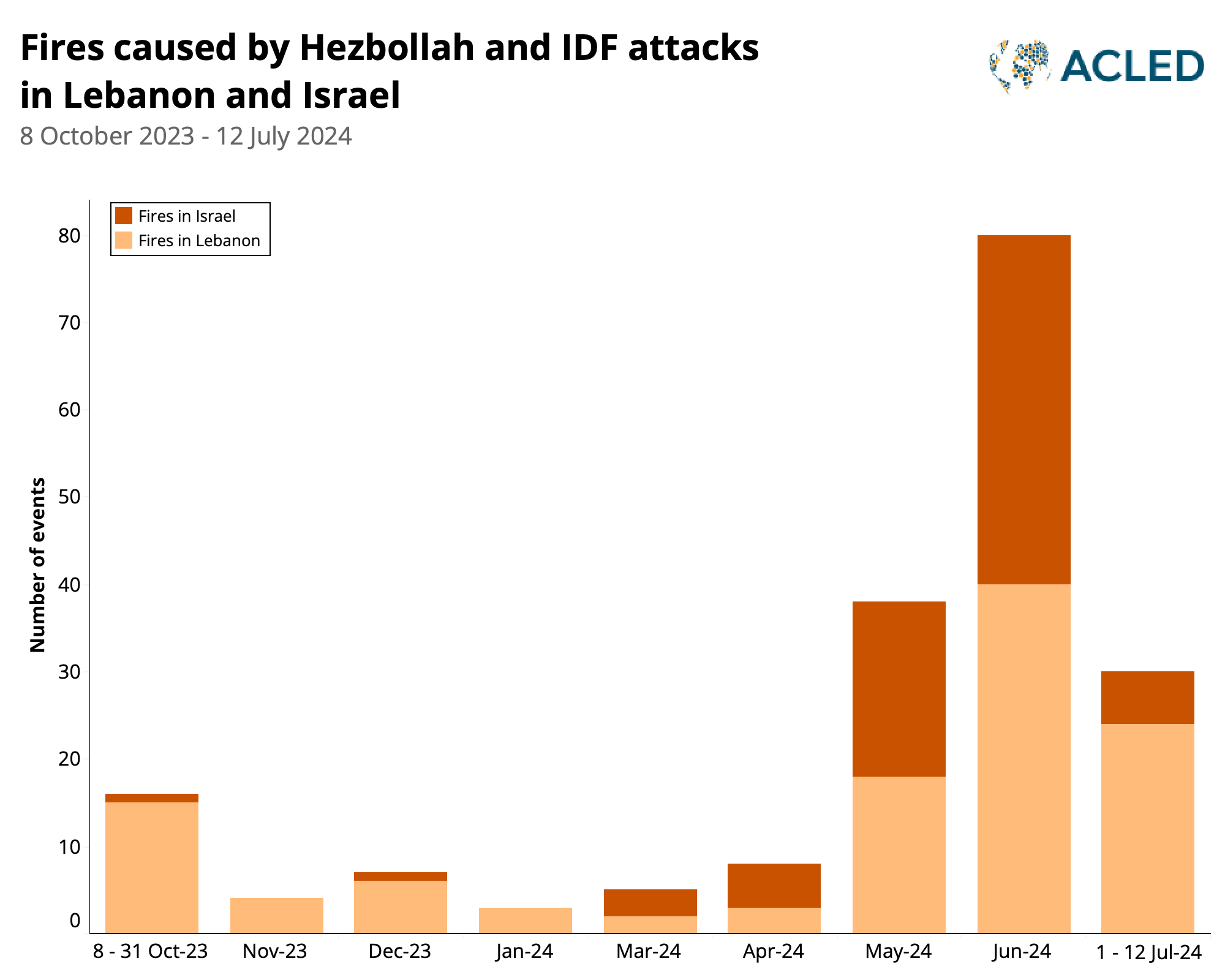Forest and farmland fires are an increasingly dangerous feature of conflict on the Israel-Lebanon border as Hezbollah and Israel inch closer to a full-blown war. They are caused by shelling, rocket, and airstrike attacks between Hezbollah and the Israel Defense Forces (IDF) that began on 8 October, when the Lebanese armed group started firing into Israel in support of Gaza, but have intensified in recent months. Since October, ACLED has recorded 191 incidents where attacks launched by Hezbollah and the IDF caused fires on either side of the border (see graph below).

In Lebanon, at least 115 forest and farmland fires have broken out as a result of Israeli attacks since October. The IDF’s use of the highly incendiary white phosphorus munition — launched in at least 294 instances — has been a significant contributing factor to the frequent outbreak of fires in Lebanon. Although the IDF claims that it does not use such shells in ways that violate international law,1Times of Israel, ‘Rights group: Israel using white phosphorus on residential buildings in Lebanon,’ 5 June 2024; Human Rights Watch, ‘Questions and Answers on Israel’s Use of White Phosphorus in Gaza and Lebanon,’ 12 October 2023 it has been accused of intentionally sparking fires2Agence France Press, ‘Two dead, fires in south Lebanon after Israeli strikes: state media,’ 9 June 2024; Sally Abou AlJoud, ‘War heightens risk of wildfires in south Lebanon this summer,’ L’Orient Today, 30 May 2024 as part of its efforts to create a buffer zone in the border area of southern Lebanon.3Justin Salhani, ‘Israel white phosphorous attacks on Lebanon harming people and ecosystem,’ Al Jazeera, 9 June 2024; Raya Jalabi, Malaika Kanaaneh Tapper, Chris Cook and Aditi Bhandari, ‘Israel’s push to create a “dead zone” in Lebanon,’ Financial Times, 27 June 2024
Experts warn of environmental damage and long-term threats to public health that can result from the use of the highly toxic substance.4Nada Maucourant Atallah, ‘Hundreds of hectares of Lebanon’s farmland destroyed by Israeli white phosphorus,’ The National, 14 November 2024 The Israeli military has also used other incendiary munitions that have exacerbated forest fires in Lebanon. In an apparent effort to burn vegetation to expose Hezbollah’s infrastructure and troop activity, Israel has recently also used a type of catapult to lob fireballs into Lebanon.5Haaretz, ‘Israel at War, Day 251: WHO Says 1,600 Kids in Gaza Under 5 Treated for Acute Malnutrition,’ 13 June 2024
From the Lebanese side, Hezbollah has launched larger salvos of rockets into Israel in recent weeks.6Emanual Fabian, ‘215 rockets fired at north after IDF killing of ‘most senior’ Hezbollah officer yet,’ Times of Israel, 12 June 2024 Amid rising temperatures, extensive forest fires have also raged across northern Israel and the occupied Golan Heights. ACLED records at least 46 incidents of fires in Israel since 1 June as a result of Hezbollah’s rockets and drones, as well as shrapnel from Israeli interceptors.
By early July, over 21,000 acres of land had burned in Israel and the Golan Heights in wildfires sparked by projectiles during the current conflict,7Associated Press and The Times of Israel, ‘Fires have become the most visible sign of the conflict on the Israel-Lebanon border,’ The Times of Israel, 4 July 2024 a larger area than during the intense 2006 war between Hezbollah and Israel.8Dina Kraft. ‘Dry Forests in Northern Israel Are Damaged as Hezbollah’s Rocket Attacks Ignite Fires,’ New York Times, 8 August 2008 The large fires in the north have increased domestic pressure on the Israeli government to show a more forceful response to Hezbollah’s attacks.9Abdelraouf Arnaout, ‘ Ben-Gvir calls for destroying Hezbollah in Lebanon amid fires in northern Israel,’ Anadolu Agency, 4 June 2024; Ronit Zilberstein and Assaf Golan, ‘“If the fire spreads to the mountain – everything changes”: Residents try to survive amid Hezbollah rockets,’ Israel Hayom, 4 June 2024
Note: The first version of this Insight cited 15,000 acres burned by mid-June, as reported by ynetnews on 16 June 2024. This was replaced with a 4 July 2024 report by The Times of Israel indicating 21,500 acres.
Visual was produced by Ciro Murillo.




